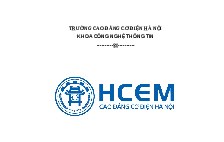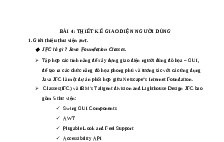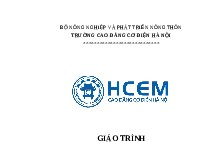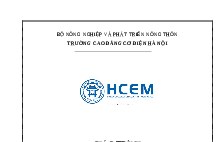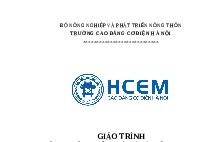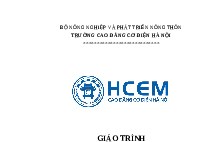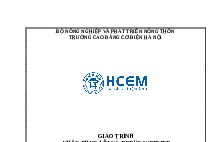SQLServerCh03
Nội dung tài liệu
Tải xuống
Link tài liệu:
Các tài liệu liên quan
Có thể bạn quan tâm
Thông tin tài liệu
Chapter 3
How to retrieve data
from a single table
Murach's SQL Server 2012, C3
© 2012, Mike Murach & Associates, Inc.
Slide 1
Objectives
Applied
Code and run SELECT statements that use any of the language
elements presented in this chapter.
Knowledge
Distinguish between the base table values and the calculated
values in SELECT statements.
Describe the use of a column alias.
Describe the order of precedence and the use of parentheses for
arithmetic expressions.
Describe the use of the DISTINCT keyword and the TOP clause.
Describe the use of comparison operators, logical operators, and
parentheses in WHERE clauses.
Murach's SQL Server 2012, C3
© 2012, Mike Murach & Associates, Inc.
Slide 2
Objectives (cont.)
Knowledge
Describe the use of the IN, BETWEEN, and LIKE operators in
WHERE clauses.
Describe the use of the IS NULL clause in a WHERE clause.
Describe the use of column names, aliases, calculated values, and
column numbers in ORDER BY clauses.
Describe the use of the OFFSET and FETCH clauses in ORDER BY
clauses.
Murach's SQL Server 2012, C3
© 2012, Mike Murach & Associates, Inc.
Slide 3
The simplified syntax of the SELECT statement
SELECT select_list
FROM table_source
[WHERE search_condition]
[ORDER BY order_by_list]
The four clauses of the SELECT statement
SELECT
FROM
WHERE
ORDER BY
Murach's SQL Server 2012, C3
© 2012, Mike Murach & Associates, Inc.
Slide 4
A simple SELECT statement
SELECT *
FROM Invoices;
(114 rows)
Murach's SQL Server 2012, C3
© 2012, Mike Murach & Associates, Inc.
Slide 5
A SELECT statement that retrieves and sorts rows
SELECT InvoiceNumber, InvoiceDate, InvoiceTotal
FROM Invoices
ORDER BY InvoiceTotal;
(114 rows)
Murach's SQL Server 2012, C3
© 2012, Mike Murach & Associates, Inc.
Slide 6
A SELECT statement that retrieves
a calculated value
SELECT InvoiceID, InvoiceTotal, CreditTotal + PaymentTotal
AS TotalCredits
FROM Invoices
WHERE InvoiceID = 17;
Murach's SQL Server 2012, C3
© 2012, Mike Murach & Associates, Inc.
Slide 7
A SELECT statement that retrieves all invoices
between given dates
SELECT InvoiceNumber, InvoiceDate, InvoiceTotal
FROM Invoices
WHERE InvoiceDate BETWEEN '2012-01-01' AND '2012-05-31'
ORDER BY InvoiceDate;
(101 rows)
Murach's SQL Server 2012, C3
© 2012, Mike Murach & Associates, Inc.
Slide 8
A SELECT statement that returns
an empty result set
SELECT InvoiceNumber, InvoiceDate, InvoiceTotal
FROM Invoices
WHERE InvoiceTotal > 50000;
Murach's SQL Server 2012, C3
© 2012, Mike Murach & Associates, Inc.
Slide 9
The expanded syntax of the SELECT clause
SELECT [ALL|DISTINCT] [TOP n [PERCENT] [WITH TIES]]
column_specification [[AS] result_column]
[, column_specification [[AS] result_column]] ...
Five ways to code column specifications
All columns in a base table
Column name in a base table
Arithmetic expression
String expression
Function
Murach's SQL Server 2012, C3
© 2012, Mike Murach & Associates, Inc.
Slide 10
Column specifications that use base table values
The * is used to retrieve all columns
SELECT *
Column names are used to retrieve specific columns
SELECT VendorName, VendorCity, VendorState
Murach's SQL Server 2012, C3
© 2012, Mike Murach & Associates, Inc.
Slide 11
Column specifications that use calculated values
An arithmetic expression is used to calculate BalanceDue
SELECT InvoiceNumber,
InvoiceTotal - PaymentTotal – CreditTotal
AS BalanceDue
A string expression is used to calculate FullName
SELECT VendorContactFName + ' ' + VendorContactLName
AS FullName
A function is used to calculate CurrentDate
SELECT InvoiceNumber, InvoiceDate,
GETDATE() AS CurrentDate
Murach's SQL Server 2012, C3
© 2012, Mike Murach & Associates, Inc.
Slide 12
Two ways to name the columns in a result set
Using the AS keyword (the preferred technique)
SELECT InvoiceNumber AS [Invoice Number],
InvoiceDate AS Date, InvoiceTotal AS Total
FROM Invoices;
Using the equal operator (an older technique)
SELECT [Invoice Number] = InvoiceNumber, Date =
InvoiceDate,
Total = InvoiceTotal
FROM Invoices;
The result set for both SELECT statements
Murach's SQL Server 2012, C3
© 2012, Mike Murach & Associates, Inc.
Slide 13
A SELECT statement that doesn’t name
a calculated column
SELECT InvoiceNumber, InvoiceDate, InvoiceTotal,
InvoiceTotal - PaymentTotal - CreditTotal
FROM Invoices;
Murach's SQL Server 2012, C3
© 2012, Mike Murach & Associates, Inc.
Slide 14
How to concatenate string data
SELECT VendorCity, VendorState, VendorCity + VendorState
FROM Vendors;
Murach's SQL Server 2012, C3
© 2012, Mike Murach & Associates, Inc.
Slide 15
How to format string data using literal values
SELECT VendorName,
VendorCity + ', ' + VendorState + ' ' + VendorZipCode
AS Address
FROM Vendors;
Murach's SQL Server 2012, C3
© 2012, Mike Murach & Associates, Inc.
Slide 16
How to include apostrophes in literal values
SELECT VendorName + '''s Address: ',
VendorCity + ', ' + VendorState + ' ' + VendorZipCode
FROM Vendors;
Murach's SQL Server 2012, C3
© 2012, Mike Murach & Associates, Inc.
Slide 17
The arithmetic operators in order of precedence
*
/
%
+
-
Multiplication
Division
Modulo (Remainder)
Addition
Subtraction
Murach's SQL Server 2012, C3
© 2012, Mike Murach & Associates, Inc.
Slide 18
A SELECT statement that calculates
the balance due
SELECT InvoiceTotal, PaymentTotal, CreditTotal,
InvoiceTotal - PaymentTotal - CreditTotal AS BalanceDue
FROM Invoices;
Murach's SQL Server 2012, C3
© 2012, Mike Murach & Associates, Inc.
Slide 19
A SELECT statement that uses parentheses
to control the sequence of operations
SELECT InvoiceID,
InvoiceID + 7 * 3 AS OrderOfPrecedence,
(InvoiceID + 7) * 3 AS AddFirst
FROM Invoices
ORDER BY InvoiceID;
Murach's SQL Server 2012, C3
© 2012, Mike Murach & Associates, Inc.
Slide 20
A SELECT statement that uses
the modulo operator
SELECT InvoiceID,
InvoiceID / 10 AS Quotient,
InvoiceID % 10 AS Remainder
FROM Invoices
ORDER BY InvoiceID;
Murach's SQL Server 2012, C3
© 2012, Mike Murach & Associates, Inc.
Slide 21
What determines the sequence of operations
Order of precedence
Parentheses
Murach's SQL Server 2012, C3
© 2012, Mike Murach & Associates, Inc.
Slide 22
A SELECT statement that uses the LEFT function
SELECT VendorContactFName, VendorContactLName,
LEFT(VendorContactFName, 1) +
LEFT(VendorContactLName, 1) AS Initials
FROM Vendors;
Murach's SQL Server 2012, C3
© 2012, Mike Murach & Associates, Inc.
Slide 23
A SELECT statement that uses
the CONVERT function
SELECT 'Invoice: #' + InvoiceNumber
+ ', dated ' + CONVERT(char(8), PaymentDate, 1)
+ ' for $' + CONVERT(varchar(9), PaymentTotal, 1)
FROM Invoices;
Murach's SQL Server 2012, C3
© 2012, Mike Murach & Associates, Inc.
Slide 24
A SELECT statement that computes
the age of an invoice
SELECT InvoiceDate,
GETDATE() AS 'Today''s Date',
DATEDIFF(day, InvoiceDate, GETDATE()) AS Age
FROM Invoices;
Murach's SQL Server 2012, C3
© 2012, Mike Murach & Associates, Inc.
Slide 25
Terms
Function
Parameter
Argument
Murach's SQL Server 2012, C3
© 2012, Mike Murach & Associates, Inc.
Slide 26
A SELECT statement that returns all rows
SELECT VendorCity, VendorState
FROM Vendors
ORDER BY VendorCity;
Murach's SQL Server 2012, C3
© 2012, Mike Murach & Associates, Inc.
Slide 27
A SELECT statement that eliminates
duplicate rows
SELECT DISTINCT VendorCity, VendorState
FROM Vendors;
(53 rows)
Murach's SQL Server 2012, C3
© 2012, Mike Murach & Associates, Inc.
Slide 28
A SELECT statement with a TOP clause
SELECT TOP 5 VendorID, InvoiceTotal
FROM Invoices
ORDER BY InvoiceTotal DESC;
Murach's SQL Server 2012, C3
© 2012, Mike Murach & Associates, Inc.
Slide 29
A SELECT statement with a TOP clause
and the PERCENT keyword
SELECT TOP 5 PERCENT VendorID, InvoiceTotal
FROM Invoices
ORDER BY InvoiceTotal DESC;
Murach's SQL Server 2012, C3
© 2012, Mike Murach & Associates, Inc.
Slide 30
A SELECT statement with a TOP clause
and the WITH TIES keyword
SELECT TOP 5 WITH TIES VendorID, InvoiceDate
FROM Invoices
ORDER BY InvoiceDate ASC;
Murach's SQL Server 2012, C3
© 2012, Mike Murach & Associates, Inc.
Slide 31
The syntax of the WHERE clause
with comparison operators
WHERE expression_1 operator expression_2
The comparison operators
=
>
<
<=
>=
Murach's SQL Server 2012, C3
© 2012, Mike Murach & Associates, Inc.
Slide 32
Examples of WHERE clauses that retrieve…
Vendors located in Iowa
WHERE VendorState = 'IA'
Invoices with a balance due (two variations)
WHERE InvoiceTotal – PaymentTotal – CreditTotal > 0
WHERE InvoiceTotal > PaymentTotal + CreditTotal
Vendors with names from A to L
WHERE VendorName < 'M'
Invoices on or before a specified date
WHERE InvoiceDate <= '2012-05-31'
Invoices on or after a specified date
WHERE InvoiceDate >= '5/1/12'
Invoices with credits that don’t equal zero
WHERE CreditTotal 0
Murach's SQL Server 2012, C3
© 2012, Mike Murach & Associates, Inc.
Slide 33
The syntax of the WHERE clause
with logical operators
WHERE [NOT] search_condition_1 {AND|OR}
[NOT] search_condition_2 ...
Examples of queries using logical operators
The AND operator
WHERE VendorState = 'NJ' AND YTDPurchases > 200
The OR operator
WHERE VendorState = 'NJ' OR YTDPurchases > 200
The NOT operator
WHERE NOT (InvoiceTotal >= 5000 OR
NOT InvoiceDate <= '2012-07-01')
The same condition without the NOT operator
WHERE InvoiceTotal < 5000 AND InvoiceDate <= '2012-07-01'
Murach's SQL Server 2012, C3
© 2012, Mike Murach & Associates, Inc.
Slide 34
A compound condition without parentheses
WHERE InvoiceDate > '01/01/2012'
OR InvoiceTotal > 500
AND InvoiceTotal - PaymentTotal - CreditTotal > 0
(100 rows)
The order of precedence
for compound conditions
NOT
AND
OR
Murach's SQL Server 2012, C3
© 2012, Mike Murach & Associates, Inc.
Slide 35
The same compound condition with parentheses
WHERE (InvoiceDate > '01/01/2012'
OR InvoiceTotal > 500)
AND InvoiceTotal - PaymentTotal - CreditTotal > 0
(11 rows)
Murach's SQL Server 2012, C3
© 2012, Mike Murach & Associates, Inc.
Slide 36
The syntax of the WHERE clause
with an IN phrase
WHERE test_expression [NOT] IN
({subquery|expression_1 [, expression_2]...})
Examples of the IN phrase
An IN phrase with a list of numeric literals
WHERE TermsID IN (1, 3, 4)
An IN phrase preceded by NOT
WHERE VendorState NOT IN ('CA', 'NV', 'OR')
An IN phrase with a subquery
WHERE VendorID IN
(SELECT VendorID
FROM Invoices
WHERE InvoiceDate = '2012-05-01')
Murach's SQL Server 2012, C3
© 2012, Mike Murach & Associates, Inc.
Slide 37
The syntax of the WHERE clause
with a BETWEEN phrase
WHERE test_expression [NOT] BETWEEN
begin_expression AND end_expression
Examples of the BETWEEN phrase
A BETWEEN phrase with literal values
WHERE InvoiceDate BETWEEN '2012-05-01' AND '2012-05-31'
A BETWEEN phrase preceded by NOT
WHERE VendorZipCode NOT BETWEEN 93600 AND 93799
A BETWEEN phrase with a test expression
coded as a calculated value
WHERE InvoiceTotal – PaymentTotal – CreditTotal
BETWEEN 200 AND 500
A BETWEEN phrase with calculated values
WHERE InvoiceDueDate BETWEEN GetDate() AND GetDate() + 30
Murach's SQL Server 2012, C3
© 2012, Mike Murach & Associates, Inc.
Slide 38
Warning about date comparisons
All columns that have the datetime data type include both a date
and time, and so does the value returned by the GetDate function.
When you code a date literal without a time, the time defaults to
12:00 AM (midnight). As a result, a date comparison may not
yield the results you expect.
Murach's SQL Server 2012, C3
© 2012, Mike Murach & Associates, Inc.
Slide 39
The syntax of the WHERE clause
with a LIKE phrase
WHERE match_expression [NOT] LIKE pattern
Wildcard symbols
%
_
[ ]
[ - ]
[ ^ ]
Murach's SQL Server 2012, C3
© 2012, Mike Murach & Associates, Inc.
Slide 40
WHERE clauses that use the LIKE phrase
Example 1
WHERE VendorCity LIKE 'SAN%'
Cities that will be retrieved
“San Diego” and “Santa Ana”
Example 2
WHERE VendorName LIKE 'COMPU_ER%'
Vendors that will be retrieved
“Compuserve” and “Computerworld”
Example 3
WHERE VendorContactLName LIKE 'DAMI[EO]N'
Names that will be retrieved
“Damien” and “Damion”
Murach's SQL Server 2012, C3
© 2012, Mike Murach & Associates, Inc.
Slide 41
WHERE clauses that use the LIKE phrase (cont.)
Example 4
WHERE VendorState LIKE 'N[A-J]'
States that will be retrieved
“NC” and “NJ” but not “NV” or “NY”
Example 5
WHERE VendorState LIKE 'N[^K-Y]'
States that will be retrieved
“NC” and “NJ” but not “NV” or “NY”
Example 6
WHERE VendorZipCode NOT LIKE '[1-9]%'
Zip codes that will be retrieved
“02107” and “08816”
Murach's SQL Server 2012, C3
© 2012, Mike Murach & Associates, Inc.
Slide 42
The syntax of the WHERE clause
with the IS NULL clause
WHERE expression IS [NOT] NULL
The contents of the NullSample table
SELECT *
FROM NullSample;
Murach's SQL Server 2012, C3
© 2012, Mike Murach & Associates, Inc.
Slide 43
A SELECT statement that retrieves rows
with zero values
SELECT *
FROM NullSample
WHERE InvoiceTotal = 0;
A SELECT statement that retrieves rows
with non-zero values
SELECT *
FROM NullSample
WHERE InvoiceTotal 0;
Murach's SQL Server 2012, C3
© 2012, Mike Murach & Associates, Inc.
Slide 44
A SELECT statement that retrieves rows
with null values
SELECT *
FROM NullSample
WHERE InvoiceTotal IS NULL;
A SELECT statement that retrieves rows
without null values
SELECT *
FROM NullSample
WHERE InvoiceTotal IS NOT NULL;
Murach's SQL Server 2012, C3
© 2012, Mike Murach & Associates, Inc.
Slide 45
The expanded syntax of the ORDER BY clause
ORDER BY expression [ASC|DESC] [, expression [ASC|DESC]]...
An ORDER BY clause that sorts by one column
SELECT VendorName,
VendorCity + ', ' + VendorState + ' ' + VendorZipCode
AS Address
FROM Vendors
ORDER BY VendorName;
Murach's SQL Server 2012, C3
© 2012, Mike Murach & Associates, Inc.
Slide 46
The default sequence for an ascending sort
Nulls
Special characters
Numbers
Letters
Murach's SQL Server 2012, C3
© 2012, Mike Murach & Associates, Inc.
Slide 47
An ORDER BY clause that sorts by one column
in descending sequence
SELECT VendorName,
VendorCity + ', ' + VendorState + ' ' + VendorZipCode
AS Address
FROM Vendors
ORDER BY VendorName DESC;
Murach's SQL Server 2012, C3
© 2012, Mike Murach & Associates, Inc.
Slide 48




